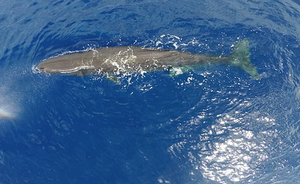Published in the ‘Biodiversity and Conservation’ scientific journal the article ‘Cetacean sensitivity and threats analysis to assess effectiveness of protection measures: an example of integrated approach for cetacean conservation in the Bonifacio Bouches.’
The study investigated the effectiveness of spatial protection measures for conserving cetacean species in the Bonifacio Bouches. Cetaceans are highly mobile and eclectic species, which interact with the environment and the human activities in a complex way. To preserve their environment, a primary tool is the establishment of marine protected areas in key sites of high ecological value.
The Bonifacio Bouches is mainly a coastal area which encompasses several Natura 2000 sites and is included in the Pelagos Sanctuary for the protection of marine mammals. Numerous regulations are applied here targeting shipping and related activities for environmental protection and navigation safety.
The study built a ‘species sensitivity index’ to summarize the main biological factors that increase the vulnerability of cetacean species (e.g. co-occurrence of more species, presence of juvenile, abundance of animals) and integrated it with an analysis of the main threats posed by the maritime traffic and the marine litter to highlight the priority areas/seasons requiring enhanced conservation efforts.
Despite the existing regulations, results showed that the intense anthropogenic pressure represents a risk for cetaceans in many areas lacking of protection. Only 11% of fin whale suitable habitat and 19% of striped dolphin resulted included within MPAs, in particular the French Iles Lavezzi, Bouches de Bonifacio and smaller coastal SCIs in Corsica. Bottlenose dolphin showed the lowest proportion of protected habitat, only partially covered by the Italian national parks of the Maddalena Archipelago and Asinara Island. The biodiversity of the Bonifacio Bouches appeared constantly exposed to important pressures and from the priority index analysis, areas of potential risk were identified in coastal waters, where the majority of maritime activities occur, but also in the offshore area of the Castelsardo Canyon, which represents a hotspot for marine biodiversity.
Outcomes of the study provide indication on candidate areas where an extension of spatial protection measures could favor the priority bottlenose dolphin species, and the areas/seasons that need improved mitigation of the main threats. Based on the results, the study specifically endorses the extension of the existing Natura 2000 sites in the study area, along with the implementation of vessel speed regulations, at least in the PSSA. In addition, mitigation actions tackling the main sources of litter should be sustained at local scale, as well as the implementation at national level of the EU Directives on plastics, with the related monitoring activities that have to be performed in a collaborative framework.
The application of similar approach in wider areas can be useful to verify protection measures for highly mobile species.
The study was conceived and conducted with the incomparable contribute of Professor Dario Angeletti of the University of Tuscia. The authors will forever keep his long-lasting example of professionality, enthusiasm and friendship.
Campana, I., Angeletti, D., Giovani, G., Paraboschi, M., & Arcangeli, A. (2022). Cetacean sensitivity and threats analysis to assess effectiveness of protection measures: an example of integrated approach for cetacean conservation in the Bonifacio Bouches. Biodiversity and Conservation, 1-25. https://doi.org/10.1007/s10531-021-02346-w

